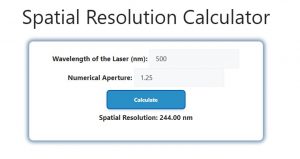About Spatial Resolution Calculator (Formula)
The Spatial Resolution Calculator is a valuable tool for scientists and engineers involved in optical systems and imaging techniques. Spatial resolution refers to the smallest detail that can be resolved in an image, significantly impacting the quality and clarity of the observed data. Understanding spatial resolution is essential in fields such as microscopy, photography, and astronomy, as it determines the level of detail captured in an image. This article explores the formula, usage, and implications of spatial resolution, along with frequently asked questions to enhance your understanding.
Formula
The formula for calculating spatial resolution is:
Spatial Resolution = (0.61 * Wavelength) / Numerical Aperture
This equation helps quantify how well an optical system can resolve detail, providing insights into the performance of various imaging systems.
How to Use
Using the Spatial Resolution Calculator is straightforward. Follow these steps:
- Determine Wavelength: Identify the wavelength of light used in your optical system, usually measured in nanometers (nm).
- Identify Numerical Aperture: Determine the numerical aperture (NA) of the optical system. This value is dimensionless and indicates the light-gathering ability of the lens.
- Input Values: Enter the values for wavelength and numerical aperture into the calculator.
- Calculate: Click the calculate button to obtain the spatial resolution value, which will be expressed in appropriate units (e.g., micrometers or nanometers).
Example
Consider a microscope using light with a wavelength of 500 nm and a numerical aperture of 1.25. To find the spatial resolution, we can use the formula:
Spatial Resolution = (0.61 * Wavelength) / Numerical Aperture
= (0.61 * 500 nm) / 1.25
= 305 nm / 1.25
= 244 nm
In this example, the spatial resolution of the microscope is 244 nm, meaning it can resolve details down to this size.

FAQs
- What is spatial resolution?
Spatial resolution refers to the smallest distinguishable detail in an image, impacting the clarity and quality of the observed data. - Why is spatial resolution important?
It determines the ability of an optical system to resolve fine details, essential for applications in microscopy, photography, and remote sensing. - What factors affect spatial resolution?
Key factors include the wavelength of light used and the numerical aperture of the optical system. - Can spatial resolution be improved?
Yes, improving the numerical aperture or using shorter wavelengths can enhance spatial resolution. - How does wavelength influence spatial resolution?
Shorter wavelengths generally lead to better spatial resolution, allowing for finer detail capture. - What is numerical aperture (NA)?
NA is a dimensionless number that describes the light-gathering ability of a lens, influencing the resolution of the optical system. - Is there a limit to spatial resolution?
Yes, the diffraction limit sets a theoretical limit on how finely details can be resolved based on the wavelength and numerical aperture. - How is spatial resolution measured?
It is typically measured in micrometers (µm) or nanometers (nm) depending on the application. - What role does spatial resolution play in microscopy?
In microscopy, higher spatial resolution allows for the visualization of smaller structures, crucial for biological and materials science research. - Are there different types of spatial resolution?
Yes, spatial resolution can vary in different imaging modalities, such as digital cameras, satellite imaging, and medical imaging. - Can spatial resolution be calculated for different wavelengths?
Yes, you can calculate spatial resolution for any wavelength by substituting the appropriate value in the formula. - How does spatial resolution affect image quality?
Higher spatial resolution generally leads to clearer images with more visible detail. - What is the relationship between spatial and temporal resolution?
Spatial resolution focuses on detail in space, while temporal resolution pertains to how quickly changes can be captured in time. - Can spatial resolution affect data interpretation?
Yes, higher resolution can provide more accurate and detailed information, aiding in better data interpretation. - What is the difference between spatial resolution and contrast resolution?
Spatial resolution relates to detail recognition, while contrast resolution pertains to the ability to distinguish differences in intensity. - Can spatial resolution be optimized in imaging systems?
Yes, through the selection of appropriate lenses, light sources, and settings, spatial resolution can be optimized. - How does the design of optical systems influence spatial resolution?
The design, including lens quality and arrangement, directly impacts the numerical aperture and, consequently, the spatial resolution. - What applications benefit from high spatial resolution?
Applications include medical imaging, material science, and any field requiring detailed observation of microscopic structures. - Can software improve spatial resolution?
While software cannot change physical limits, it can enhance images through techniques like super-resolution imaging. - Is spatial resolution the same for all optical systems?
No, spatial resolution varies significantly between different optical systems, such as microscopes, telescopes, and cameras.
Conclusion
The Spatial Resolution Calculator is a crucial tool for anyone involved in imaging and optical design. By understanding and calculating spatial resolution, you can enhance the performance of optical systems, optimize imaging techniques, and achieve clearer, more detailed results. With the proper inputs and understanding, the spatial resolution can greatly influence the effectiveness of research and applications across various fields.